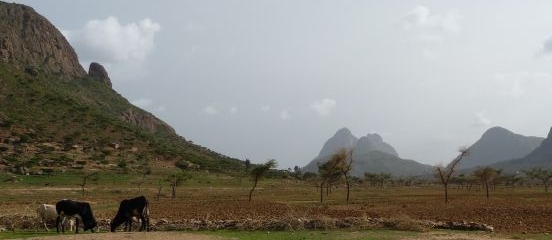A Farm Africa day in Tigray
16 April 2014

By Lord Cameron of Dillington, Chair of the All-Party Parliamentary Group on Agriculture and Food for Development, UK.
As Chair of the All-Party Parliamentary Group on Agriculture and Food for Development, I have worked with Farm Africa for many years in our crusade to promote improved smallholder agriculture as the best means of helping African people to become more self-reliant and self-sufficient. So it seemed too good an opportunity to miss to see what they were doing when my wife and I were on holiday in northern Ethiopia in the province of Tigray in February. I had met the energetic and enthusiastic Michelle Winthrop (Farm Africa’s Director of Ethiopia) in Addis Ababa when on a Parliamentary visit there last November, and she had suggested we make a point of looking at their work in Tigray during our visit. Tigray is one of the poorest states in Ethiopia. It is still recovering from the 1998-2000 war with Eritrea and is not blessed with a benevolent climate or rich soils.
So after an early morning spent visiting the ancient artefacts of Axum, which include the giant obelisks known as Stellae dating from 300AD, the chapel which houses the Ark of the Covenant (aspiring Indiana Joneses please note!) and the 3000-year-old Palace of the Queen of Sheba, we met up with Desta Araya who took us out into the countryside to see Farm Africa’s work in Tigray. We visited and learnt about projects involving bees, goats and chickens as well as visiting a now well-established water management project.
 The bee project is simple and involves providing farmers with two hives each and teaching them how to manage the bees, harvest the honey and sell it. The biggest problem for the participants (200 of them in just over 12 months) is finding enough flowering plants for the bees - sometimes they had to carry the hives on their heads into the hills at night, when the bees were asleep, in order to find more plants. But at least to some extent the bees work by themselves to provide the vital extra cash, meaning the participants can remain available for whenever a rare opportunity presents itself for earning a few Ethiopian birr.
The bee project is simple and involves providing farmers with two hives each and teaching them how to manage the bees, harvest the honey and sell it. The biggest problem for the participants (200 of them in just over 12 months) is finding enough flowering plants for the bees - sometimes they had to carry the hives on their heads into the hills at night, when the bees were asleep, in order to find more plants. But at least to some extent the bees work by themselves to provide the vital extra cash, meaning the participants can remain available for whenever a rare opportunity presents itself for earning a few Ethiopian birr.
The goats need a bit more management: each woman (487 of them since Jan 2013) received three pregnant goats which they have to feed and manage. Again the biggest problem is finding the raw materials to keep them healthy: some women grow very small plots of fodder, but mostly they are dependent on collecting straw and other gleanings from their neighbouring farmers and gathering wild vegetation from the countryside. But the problem they have is that the law forbids them to cut bushes and branches from the hills in case the resultant denuding of the slopes causes erosion or worse during the rainy season. However, the goats we saw looked healthy enough, and interestingly everyone had the ambition to build up their herd so they could afford to buy a cow to make them more self-sufficient – so the fodder problem can’t have been overwhelming! We didn’t have time to talk to any of the 563 women who had each been given 15 chickens as the basis of a flock, nor the 400 beneficiaries of the fruit and vegetable scheme who had been given seeds and irrigation equipment to kick-start their enterprises. But we were very impressed by the number of people in total who had been reached in such a short time within the 30 or so villages covered by the project.
At the end of the afternoon we visited a valley where, some 15 years ago, by some well-placed and simple water management measures, a community had been saved from desertification. In a way, it was as much about soil improvement as water conservation, but this valley, which we were told had been about to be abandoned by its people, had been helped by Farm Africa to become a model of smallholder soil and water management. Each plot was guaranteed a given amount of water to grow the wide mixture of crops in which the community had now become expert in managing and marketing. It seemed that the project had become so famous and won so many awards that farmers came from far and wide to listen and learn. It was certainly humming with activity and learning when we were there.
The work being done by the Farm Africa in Tigray is hugely impressive, and we had a really interesting day. Even the Ethiopian tour guide who chose to accompany us was impressed. Through this channel, I would like to thank all the Farm Africa team in Ethiopia for looking after us so well, and for the work they are doing to improve so many lives.

